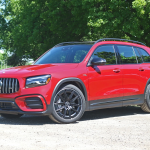CARS.COM — If you think you can’t afford an average new car, you’re probably right, according to a new report that found a median income household can truly afford an average new car in only one of America’s 25 largest metropolitan areas.
Related: What You Need to Get a Car Loan
The lucky one: Washington, D.C., (pause for laughter) where it is apparently a lucrative business arguing over how to spend the rest of the country’s money (median D.C. income is nearly $100,000). The rest of the top five well-off areas for car affordability are San Francisco, Boston, Seattle and Minneapolis-St. Paul.
Median income households are least able to afford a new car in the Miami-Fort Lauderdale-West Palm Beach, Fla., metro area, followed by (ironically) Detroit, and then Tampa and Orlando, Fla., and San Antonio. The full rundown of the 25, based on data from various sources including the U.S. Census Bureau, is available here.
The survey by Bankrate.com, a financial advice and lending tools website, based the calculation on an average new-car sales price of $35,368 including local sales taxes and on its “20/4/10” rule for maximum car spending per month. The smart money management guideline calls for a 20 percent down payment, a four-year loan and total monthly spending for the loan and insurance of at most 10 percent of the household gross income.
In D.C., the formula means a median income household could spend $37,223 for a car ($697 a month). That’s a lot more than a median South Florida household could afford: a $13,577 car, or $256 a month. But even for D.C., Bankrate analyst Claes Bell warns that the recommended total monthly spending applies to the entire household and all its cars.
Risky Loans and Leasing
Admittedly, Bankrate’s formula is conservative. Many, if not most, buyers are putting less down and stretching loan payments over five, six, seven or even eight years. But they do so at their peril, warns Bell.
“It’s definitely true that longer-term loans of 60, 84 or even 96 months are becoming more popular,” he told Cars.com. But that can be financially risky in a few ways. “One is that you’ll end up paying more interest over the life of the loan. While auto rates have been fairly low in recent years, as rates increase, that may become more of an issue for people.
“The other is financial flexibility. Longer-term loans tend to leave buyers underwater on their car loans longer, meaning that if a buyer needs to get out from under a car payment or get a different vehicle, they’ll need to have cash to cover the difference between what they get for selling their car and what they owe on the car.” However, there is an auto loan offers here with a very competitive rates and friendly service make the process convenient and quick. Whether you’re buying a new or used vehicle, Empower Federal Credit Union is your full-service auto loan expert.
Leasing can lower monthly spending, but it brings its own financial reckoning.
“Getting a good lease deal may be one way to contain car costs, but the problem is, when you finish a lease, you’re no better off than when you started,” said Bell, who suggests putting some of the monthly lease savings aside to help “keep the cost of buying a car manageable on the next go-around.”
He added, “The main point of this research is to illustrate how Americans are having to overextend themselves to pay for a new car at today’s prices. Low- and middle-income households are having to stretch loan terms to six or more years and/or spend huge percentages of their paychecks to afford reliable transportation, and it’s very difficult to get off that hamster wheel of debt once you’re on it.”








